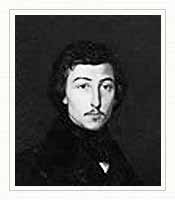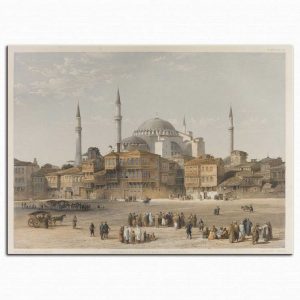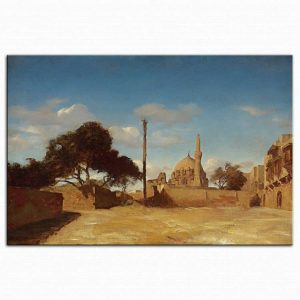
Prosper Marilhat (1811 – 1847)
Prosper Marilhat was born in Vertaizon, France. Despite the brevity of his career, Prosper Marilhat emerges as one of the “classics” of the Orientalist movement. He was astonishingly active, accumulating sketches and studies, but due to his mental illness and premature death, he left hundreds of paintings only partially finished. While a vast quantity of articles was written about him during the nineteenth century, no recent single study had been made until that of Danielle Menu, who has devoted years of patient research to the matter.
A banker’s son, Prosper Marilhat spent his childhood in the château de Sauvagnat, in Auvergne. His father having settled in Thiers, he attempted, unsuccessfully, a commercial career in cutlery, the local craft. Aged eighteen, he studied with Camille Roqueplan in Paris, and exhibited at the Salon for the first time in 1831, with a landscape of Auvergne.
Travelling
Marilhat’s opportunity to visit the Near East came when he was employed as a draughtsman to accompany a scientific expedition led by the baron von Hugel, a rich botanist, politician and soldier. They left for Greece and Egypt in April 1831. In the following months, Marilhat led a nomadic life, travelling through Syria, Lebanon and Palestine, returning to Egypt from Jaffa. His studies of majestic caravans and encampments in bleak deserts date from this period. Marilhat refused to accompany the baron, who was setting off for India, for he had become passionately attracted to Egypt. Not only did he see faces which he found exactly resembled those of ancient Egyptian sculptures, but he was particularly struck by the nobility and grandeur of the land and its people.
Late 1832 found him in Alexandria where he was ” painting portraits in order to live and doing studies in order to learn. ” He painted Mehemet (Mohammed) Ali and the Egyptologist Prisse d’Avennes, as well as local notables, and even designed stage sets for the local theatre. The fees from these activities allowed him to prolong his stay, and he explored the Nile delta until May of the following year, when he returned aboard the Sphinx, which was carrying the Luxor obelisk.
Exhibitions
Marilhat’s works in the 1834 Salon were a revelation to the public. The critics, particularly Theophile Gautier, were unanimously favourable. The famous painting of La Place de l’Esbekieh et du quartier copte au Caire (Ezbekiyah Square and the Copt Quarter in Cairo) inspired Gautier with “a nostalgia for the Eastern world, in which I had never set foot. It seemed to me that I had just experienced the revelation of my true fatherland, and when my gaze detached itself from this ardent painting, I felt as if I had been exiled.”
Marilhat continued to paint portraits and European landscapes, as well as Orientalist subjects. But he began displaying signs of mental disturbance early on. Although his eight paintings at the 1844 Salon were a triumph, elevating him to the height of his reputation, he felt that he deserved greater attention. The progress of his illness prevented him from carrying out his plans to return to Egypt and he was instead given an annual pension by the French government, thanks to the initiative of Prosper Merimee and the painter Camille Corot. It was too late ; Marilhat died, mad, in Paris after a short stay in his family’s town, Thiers.
Drawings
Marilhat’s delicate drawings, often heightened with touches of sanguine and chalk, show his concern for accuracy. But his oil paintings, despite his sincerity and true appreciation of the East, were less objective: his landscapes, in over-rich colours, bathed in perpetual sunlight, without nuances or half-tones, are not always to the modern taste. His work was particularly well-known in his lifetime through the publications of engravings by various artists, many of which are now in the Cabinet des Estampes in Paris and the British Museum, London. This success meant, however, that many copies of his paintings were made both during his lifetime and in the years following his death. His oils, rarely seen on the market, are to be found in many museum collections in Europe and the United States.
Literature:
H. Gomot, Marilhat et son oeuvre, Clermont-Ferrand, 1844;
D. Menu, Prosper Marilhat, essai de catalogue (thesis), Dijon University, 1972.
The Orientalists, Lynne Thornton, ACR, 1983


